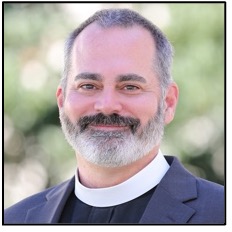This is the weekly bulletin insert from Sermons That Work.

During the Easter season, Sermons That Work is pleased to present reflections from some of the newest bishops of The Episcopal Church on the resurrection of our Lord. Check back each week for a brief exploration of how Jesus Christ’s rising from the grave changes everything.
To listen to this reflection, scan the QR code on this page and subscribe to the Sermons That Work podcast.
Reflections on the Resurrection: Week 4
Rather than minimize grief, Jesus experiences it and comforts others in it. But mourning is not the final word. Resurrection is. He gives a word of comfort to those in distress. The knowledge of his resurrection is our hope and a major way of dealing with sorrow: “Let not your hearts be troubled. Believe in God; believe also in me. In my Father’s house are many rooms. If it were not so, would I have told you that I go to prepare a place for you? And if I go and prepare a place for you, I will come again and will take you to myself, that where I am you may be also” (John 14:1-3).
The Bible teaches that our suffering is a place to experience God’s sustaining grace in our weakness (2 Cor. 1:8-9). It is clearly taught that grief is a natural response when one experiences loss, but it can be tempered by the knowledge of Christ and the resurrection.
The loss that causes grief is very real, but it is temporary. The knowledge that softens the blow of grief is not an abstract platitude but the real resurrection of Jesus (1 Cor. 15). Our grief now is in the context of a future hope (1 Thess. 4:13-18). The hope of the new creation frames, but does not erase our present mourning: “Behold, the dwelling place of God is with man. He will dwell with them, and they will be his people, and God himself will be with them as their God. He will wipe away every tear from their eyes, and death shall be no more, neither shall there be mourning, nor crying, nor pain anymore, for the former things have passed away” (Rev. 21:3-4).
Jesus Christ calls himself “the light of the world” and entered into the darkness of this world to bring light and eternal life to sinners who are dwelling in the darkness of their rebellion and sin: “The people dwelling in darkness have seen a great light, and for those dwelling in the region and shadow of death, on them a light has dawned” (Matt. 4:16).
Where darkness, death, and decay had reigned, Jesus breaks in with light, liberation, and love. A picture of this comes from Robert Louis Stevenson, the author of Treasure Island, who lived in Scotland in the nineteenth century. As a boy, his family lived on a hillside overlooking a small town. Robert was intrigued by the work of the old lamplighters who went about with a ladder and a torch, lighting the streetlights for the night. One evening, as Robert stood watching with fascination, his nurse asked him, “Robert, what in the world are you looking at out there?” With great excitement he exclaimed: “Look at that man! He’s punching holes in the darkness!”
The light of the world has entered into the world’s darkness in order to punch holes in it and bring those who dwell in darkness into the dawn of his grace and truth. None of this would be possible apart from Christ’s incarnation, life, death, and resurrection.

The Rt. Rev. Dr. Justin S. Holcomb is the bishop of the Diocese of Central Florida, a seminary professor, and an author or editor of more than twenty books on theology, abuse, and biblical studies.
Published by the Office of Formation of The Episcopal Church, 815 Second Avenue, New York, N.Y. 10017
© 2024 The Domestic and Foreign Missionary Society of the Protestant Episcopal Church in the United States of America. All rights reserved.
Weekly bulletin inserts
This weekly bulletin insert provides information about the history, music, liturgy, mission, and ministry of The Episcopal Church. For more information, please contact us at stw@episcopalchurch.org.

Sermons That Work
For more than 20 years, Sermons That Work, a ministry of The Episcopal Church’s Office of Communication, has provided free sermons, Bible studies, bulletin inserts, and other resources that speak to congregations across the Church. Our writers and readers come from numerous and varied backgrounds, and the resources we provide are used in small house churches, sprawling cathedrals, and everything between.

Church of the Redeemer
Church of the Redeemer: Worshiping God, living in community, and reaching out to the world around us. We are an Episcopal Church serving north King County and south Snohomish County, Washington. As you travel your road, go with friends walking the way of Jesus at Redeemer.
Church of the Redeemer is at 6210 Northeast 181st Street in Kenmore, Washington. The campus is a short distance north of Bothell Way, near the Burke-Gilman Trail. The entrance looks like a gravel driveway. The campus is larger on the inside than it is on the outside. And we managed to hide a large building on the side of a hill that is not easily seen from the street.
The Episcopal Church welcomes you.



